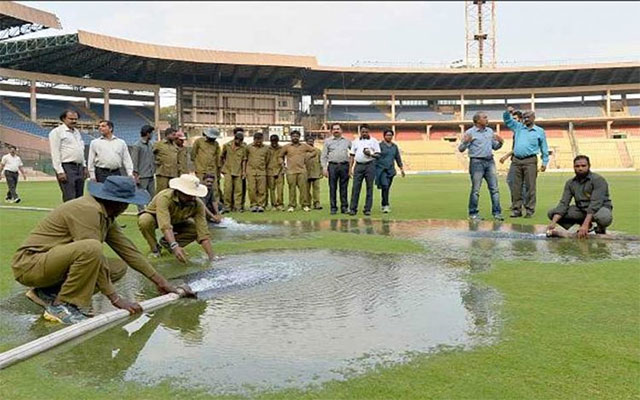IPL 2025: How subair drainage system works at M Chinnaswamy Stadium, Bengaluru? All you need to know about RCB vs PBKS match venue tech
The facility at Bengaluru's M Chinnaswamy Stadium is run by a 200-horsepower machine developed by US-based SubAir, which is enough to drain a mind-boggling 10,000 litres of water per minute.
4 Min Read


How SubAir System at M Chinnaswamy keep IPL 2025 matches on track?
The thrill of the T20 cricket festival is in full swing as IPL 2025 (Indian Premier League) marches ahead, with the Royal Challengers Bengaluru (RCB) hosting Punjab Kings (PBKS) at the iconic M. Chinnaswamy Stadium in Bengaluru. Notably, the upcoming encounter is set to take place on Friday, April 18.
However, with the weather seemingly ready to play spoilsport during the IPL fixture, the venue boasts a game-changing feature installed to ensure smooth gameplay—even if rain causes any delays during the T20 contest. The M. Chinnaswamy Stadium is equipped with an advanced drainage facility known as the SubAir System. The SubAir has become an integral part of the venue, especially when unexpected rain showers attempt to disrupt the action.
For those still unaware of how the SubAir System works and why it has been a boon for the venue in enabling cricket matches to continue amid adverse weather conditions, let’s dive in and understand the key functions of the system:
1. What is the SubAir System?
The SubAir System uses advanced air circulation technology along with sophisticated drainage tools to help keep the surface of the ground in top condition. Notably, the system is installed just beneath the surface of the Chinnaswamy ground, which assists in draining rainwater quickly without damaging the turf.
2. How does it work?
The setup uses a system of multiple air pumps and drainage pipes to extract excess water from the wet ground—especially the pitch. Let us understand its functions below:
- Water Drainage: Speaking of the advanced drainage system—it starts working like magic the moment rainwater begins to collect on the pitch or other parts of the ground. It draws out excess water with the help of drainage tubes installed beneath the surface.
- Air Circulation: Furthermore, this refined drainage system not only removes water but also circulates dry air beneath the surface, which helps dry the pitch or the field more quickly. As a result, a rain-halted match doesn’t face further delays and can resume sooner than is typically expected elsewhere in the cricketing world.
3. Quick drainage leads to faster game resumption
- Efficiency: As far as efficiency is concerned, the SubAir System is estimated to drain up to three inches of water in just 30 minutes. This becomes even more important for the successful hosting of IPL matches.
- Controlling Delays: The advanced drainage system helps avoid long delays—unlike in earlier years—and significantly reduces the chances of an IPL game being abandoned. Most importantly, the pitch is restored to playing condition even after a significant downpour.
4. Benefits of SubAir System
- Prevents Puddles: One of the most profound impacts of having this system at M. Chinnaswamy Stadium is that it prevents the formation of puddles or water pooling on the field. Traditional drainage systems often struggle with this issue, which can drastically affect playing conditions.
- Pitch Quality: The drainage system ensures that the overall health of the pitch remains unaffected by regulating moisture levels, while also making sure the match is played on a dry and safe surface. This promotes fair play and provides a balanced wicket for both batters and bowlers.
- Prevents Uneven Surfaces: Over time, poor drainage can not only damage the pitch but also result in uneven playing surfaces. However, the SubAir System helps maintain the ground in excellent condition, which also extends its overall lifespan.
5. Importance in the IPL
When the stakes are high between IPL franchises, the SubAir System plays a crucial role in minimizing rain delays at M. Chinnaswamy Stadium. This ultimately allows fans to enjoy uninterrupted cricket action. Especially for a team like RCB, which has passionate supporters, any rain delay can lead to frustration, and this system helps keep that at bay.
Weather conditions for RCB vs PBKS – IPL 2025 match
As on Friday, April 18, the 'Garden City' of Bengaluru is experiencing cloudy skies along with light drizzles ahead of the high-voltage RCB vs PBKS IPL 2025 clash. According to AccuWeather, tonight’s temperature is expected to range between 25°C and 27°C, with humidity levels around 65%.
While earlier forecasts had predicted thunderstorms around the venue in the evening, the threat of rain has seemingly reduced as match time approaches. However, the drizzle may still cause a slight delay in proceedings. On the bright side, with the availability of a world-class drainage system in the form of SubAir, the match is expected to proceed with minimal disruption.
RCB vs PBKS IPL Stats at M Chinnaswamy Stadium, Bengaluru
Download Our App